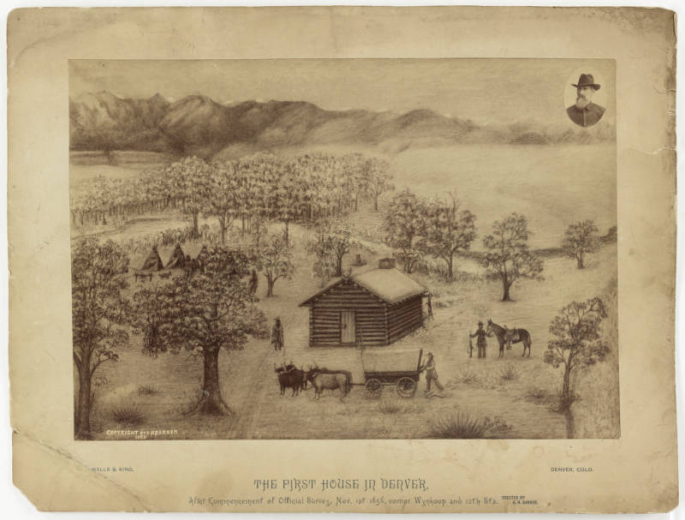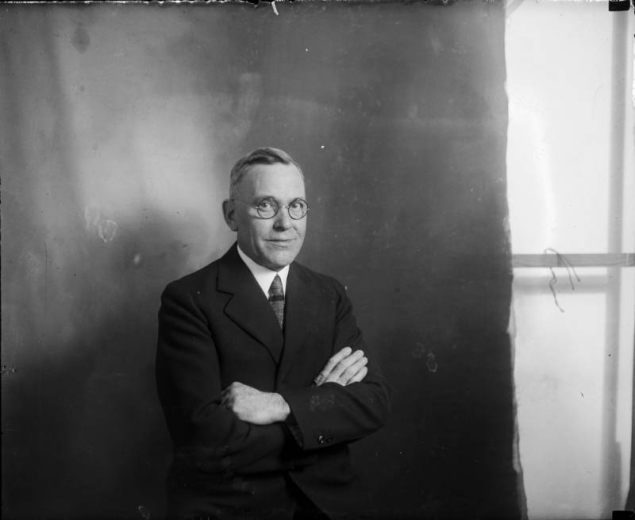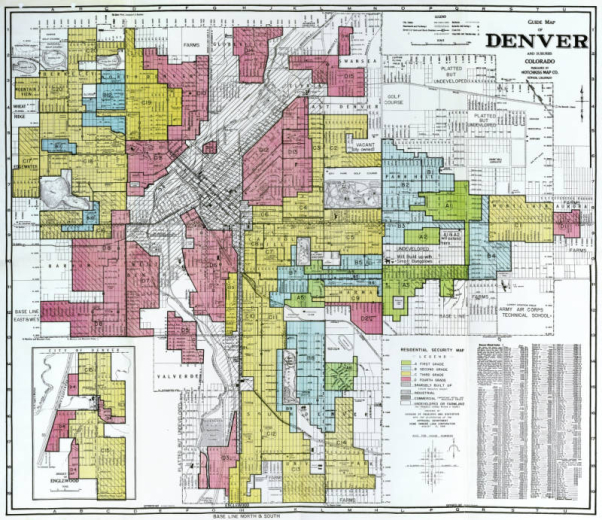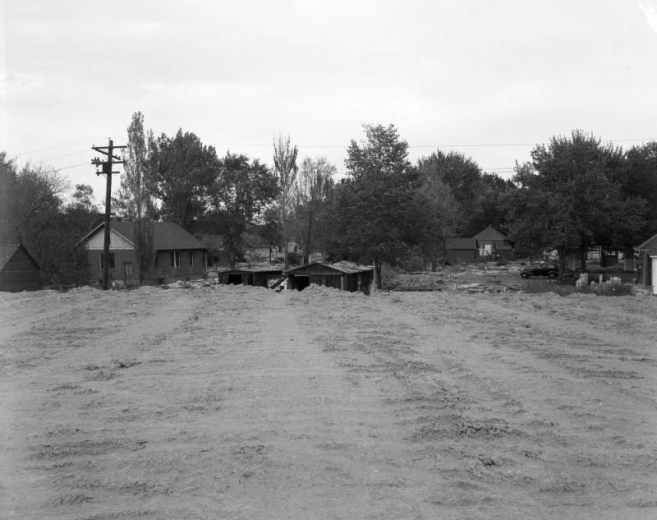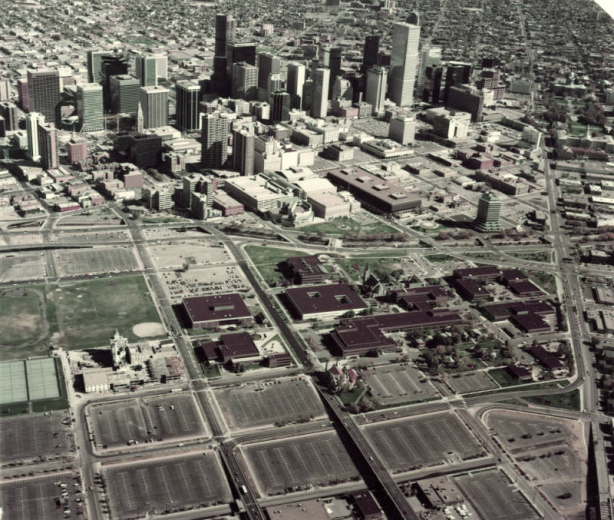This is a guide to the published and unpublished records that document major events of displacement in Denver's history. It should be noted that this guide is in no way comprehensive in capturing all occurrences of displacement to Denver residents. While some of these records are available digitally, most are available for in-person research only through DPL's Special Collections and Archives at the Central Library.
An additional recommended guide closely related to this topic is Where to Find It: Denver Building History Resources.
Disclaimer: Our collections contain racist, sexist and violent imagery and language that may be upsetting and traumatizing to our customers. By making sure historical materials are publicly available, the library acknowledges shameful injustice in our history to prompt open discussions, further historical scholarship, and support an informed and educated public.
The area that is now Denver was once used by the Cheyenne and Arapaho peoples as a seasonal camp. Unjust treaties drawn up by the United States federal government placed restrictions on this land, and on November 29, 1864, violence carried out by Colonel John M. Chivington and U.S. volunteer soldiers ended in the murder of an estimated 230 Cheyenne and Arapaho people — the majority of them were women, children, and the elderly.
Resources:
- Fort Laramie Treaty of 1851
- Treaty between the United States and the Sioux, Cheyenne, Arapaho, Crow, Assiniboin, Gros Ventre, Madan, and Arikara Indians at Fort Laramie, Indian Territory
- Treaty between the United States and the Sioux, Cheyenne, Arapaho, Crow, Assiniboin, Gros Ventre, Madan, and Arikara Indians at Fort Laramie, Indian Territory
- 1861 Treaty of Fort Wise (with transcription)
- Sand Creek Massacre
- Sarah Hively Diary (M356)
- John M. Chivington Papers (M1594)
- Silas S. Soule Papers (WH1690)
- John Lewis Dailey Papers (WH94)
- The Rocky Mountain News (weekly)
- The Rocky Mountain News (daily)
On October 31, 1880, a pool table dispute turned into a full-blown riot when a white mob pillaged Denver's Chinatown. The incident, fueled by escalating anti-Chinese sentiment in Colorado, resulted in the murder of Look Young, injuries to dozens of people, the destruction of Chinese homes and businesses, and the fleeing of 100 Chinese residents.
Resources:
- The Rocky Mountain News (weekly)
- The Rocky Mountain News (daily)
- The road to Chinese exclusion : the Denver riot, 1880 election, and rise of the West by Zhu Liping
City and Householder Directories
Denver City Directories date from 1873 and are arranged by name of resident or business name. Many also list occupations. Denver Householder Directories date from 1924 and are arranged by address and show owners, residents, and business names.
Published in 1901, Smiley’s History of Denver was originally compiled for the Denver Times. Jerome Smiley’s book gives a very detailed early history of Denver and the region. Beginning with the development of local geological formations, Smiley takes the reader through prehistoric inhabitants, Spanish and French exploration of the area, fur traders and trappers, early settlers, the growth of Denver, and finally Denver’s prospects for the future.
Beginning in the early 1920s, Denver's urban planning efforts reflected the KKK values of its leaders. Discrimination against African Americans, Catholics, and Jews was formalized in ordinances and deed restrictions.
Resources:
- Hooded empire: the Ku Klux Klan in Colorado / Robert Alan Goldberg
- Building zone ordinance and zone map : & amendment to the City Charter adopted May 15, 1923
- City and County of Denver, state of Colorado, building zone map : as adopted by the City Council February 9, 1925 ; ordinance no. 14, series of 1925.
- Denver Clerk and Recorder Land Records Database
- Index of ordinances, City and County of Denver, 1927-1933
- Denver city ordinances
- Ku Klux Klan membership ledgers for the greater Denver area (History Colorado)
- Benjamin Stapleton Papers (WH383)
- Stapleton was a member of the Ku Klux Klan and served two terms as Mayor of Denver from 1923 to 1931 and 1935 to 1947
- Newspapers
- The Rocky Mountain News (daily)
- The Denver Star (African American newspaper)
- Denver Jewish News and Intermountain Jewish News
- The Rocky Mountain American (KKK-affiliated newspaper)
- Denver city ordinances
- Zoning ordinance of the City and County of Denver [compendium of revisions from 1925 to 1942]
- Board of Adjustment for Zoning Records | WH2379 (1925-1969)
- Denver Zoning maps
- Denver City Council Meeting Minutes, Ordinances, Proclamations, Resolutions (1865-present)
Mapping Prejudice in Denver: 1931-1935 Interactive Map
A StoryMap that reveals findings of a 2022 grant-funded review of 144,000 Denver land records from 1931-1935. Explicit racism was identified in over 300 real estate deeds. This interactive map shows the modern address of each restriction and provides details about the restriction itself.
Redlining originated with 1930s New Deal homeownership initiatives that sought to provide government-insured mortgages as a way to prevent widespread foreclosures. The Federal Housing Administration (FHA) introduced color-coded maps to assess the creditworthiness of neighborhoods in over 200 cities and towns nationwide.
Neighborhoods were graded from "A" to "D" — "A" being most desirable while"D" being where property values were anticipated to decline. D neighborhoods were marked in red ("redlined") and deemed unsuitable for inclusion in homeownership and lending initiatives. As a result, people living in redlined neighborhoods were denied access to credit, even if they personally qualified for loans. It is important to note that the majority of redlined neighborhoods were inhabited by Black residents.
Resources:
- Residential Security Map (1938 redlining map)
- Area Descriptions of Denver, 1938
- Newspapers
- The Rocky Mountain News (daily)
- The Denver Star (African American newspaper)
- Underwriting Manual : Underwriting and Valuation Procedure Under Title II of the National Housing Act, With revisions to February 1938 by the United States Federal Housing Administration
- Redlining and disinvestment as a discriminatory practice in residential mortgage loans by University of Illinois at Chicago Circle, Urban-Suburban Investment Study Group
The Valley Highway project looked to build an efficient roadway from Greeley to Colorado Springs. Part of the project included the purchase (and in some cases, condemnation) of homes in Denver to make way for the highway. The result was the destruction of entire neighborhoods and the displacement of an estimated 15,000 Denver residents.
Resources:
- Preliminary report on a north-south limited-access highway through Denver. : A report rendered to Charles D. Vail, State Highway Engineer of Colorado, Colorado. Department of Highways, 1944
- City and County of Denver Valley Highway Project (WH2007)
- Valley Highway, with relation to present street system / Colorado State Highway Department (map)
- Rocky Mountain News Collection (WH2129)
- Sam Shepard Slide Collection (C Photo Collection 228)
- The Rocky Mountain News (daily)
- The Valley Highway: A North-South Limited-Access Highway Through Denver
The June 1965 flood that submerged Denver's Auraria neighborhood prompted a thorough examination of the area, leading to plans for extensive urban redevelopment. The establishment of Metropolitan State College, alongside proposals to place campuses of the University of Colorado and Denver Area Community College in a central urban location, spurred the initiative to transform Denver's oldest neighborhood into a modern urban campus. Funding for land acquisition and relocation from the federal government, particularly Housing and Urban Development (HUD), was supplemented by a voter-approved bond. Consequently, Auraria residents were displaced, with many relocating to neighboring Lincoln Park, which faced an influx of new residents. By 1972, relocations were completed, and the Auraria campus was finished in 1976.
Resources:
- Directory of Ninth Street Historic Park 1924-1973: A list of 770 residents, their occupations and with comments
- Auraria Neighborhood History (research guide)
- Archives collections
- Denver Urban Renewal Authority Records (WH914)
- Auraria Remembered Oral History Project (OH500)
- Don and Carolyn Etter Papers (WH1974)
- Magdalena Gallegos Papers (WH1364)
- Thomas G. Currigan Papers (WH929)
- Edward D. White, Jr. Architectural Records (WH1753)
- William C. Muchow Architectural Records (WH1288)
- Rocky Mountain News Records (photos and clippings)
- Newspapers
Denver Urban Renewal Authority (DURA) Relocation List
Indexed list of residents displaced during the development of the Auraria campus. Compiled by Denver Urban Renewal Authority (DURA). Held by Auraria Library.
Auraria Residents (1956-1974) StoryMap
This visual tool combines a database of Auraria residents (1956-1974) and their addresses with a map of the Auraria neighborhood. A project by History Colorado and The University of Colorado Denver Department of Geography & Environmental Sciences.

